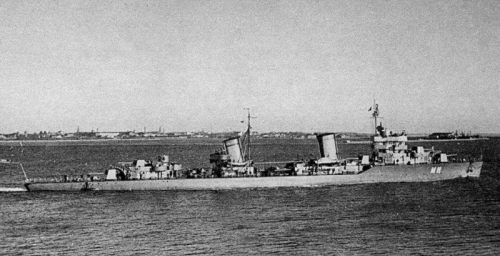

Minsk 1940

Baku 1944

Baku 1945
| Name | No | Yard No | Builder | Laid down | Launched | Comp | Fate |
| project 38 | |||||||
| Минск [Minsk] | 471 | 190 Zhdanov Yd, Leningrad | 10.1934 | 6.11.1935 | 2.1939 | TS 7.1951, training hulk 4.1953 | |
| project 38bis | |||||||
| Серго Орджоникидзе [Sergo Ordzhonikidze] (ex-Орджоникидзе [Ordzhonikidze], ex-Киев [Kiev]), 9.1940- Баку [Baku] | 267 | 198 Marti Yd, Nikolayev // 199 Yd, Komsomolsk-on-Amur | 1.1935 // 3.1936 | 25.7.1938 | 12.1939 | target 4.1958 | |
| Тбилиси [Tbilisi] (ex-Тифлис [Tiflis]) | 268 | 198 Marti Yd, Nikolayev // 199 Yd, Komsomolsk-on-Amur | 1.1935 // Summer 1936 | 24.7.1939 | 12.1940 | target 4.1958 | |
|
Displacement standard, t |
1952 |
|
Displacement full, t |
2597 |
|
Length, m |
127.5 |
|
Breadth, m |
11.7 |
|
Draught, m |
4.14 mean 4.18 max |
|
No of shafts |
3 |
|
Machinery |
3 geared steam turbines sets, 3 water-tube triangle boilers |
|
Power, h. p. |
66000 |
|
Max speed, kts |
36 |
|
Fuel, t |
oil 621 |
| Endurance, nm(kts) | 2100(20) |
|
Armament |
5 x 1 - 130/50 B-13, 3 x 1 - 76/52 34K, 2 x 1 - 45/43 21K, 6 x 1 - 12.7/79, 2 x 4 - 533 TT, 2 DCR (25), 76 mines |
| Electronic equipment | Mars hydrophone |
|
Complement |
250 |
Project history:
First combat ships designed and built in the USSR after a
long-term break, called by revolution and civil war. The design assignment of
the first Soviet destroyer leader has been approved 1.11.1928 (preliminary works
were conducted since 1925). It provided creation of large ship, on armament and
speed exceeding as available Noviks, and the majority foreign
destroyers. The basic project 1 was approved
in February, 1930, and in the end of 1932 under it building of 2 ships for Black
Sea Fleet and 1 for Baltic Fleet was begun.
Hulls of project 1 leaders differed by considerable slenderness, sharp stern
streamlines, and also absence of propeller shafts A-brackets: they were replaced by so-called "trousers".
Triple-shaft machinery was placed
en echelon in five compartments. It has predetermined a characteristic outline profile with two widely
placed
funnels and a high fore superstructure. Leaders received new
B-13 130mm/50 guns, but their long-term
development has delayed commission of ships. Besides, gun No3 was placed unsuccessfully and had limited arcs of fire.
Fire control system was Italian by Galileo. 533mm TTs were applied for the first time
in the Russian / Soviet Navy. The original project provided seaplane, but later it
was refused.
On trials all ships have significantly exceeded a designed speed. Leningrad has shown 43kts at 2225t and 67250hp; Moskva 43.57kts at 2330t and 77725hp. However the insufficient hull strength, crankiness and bad manoevreability on low speed were been revealed. In a result, after formal commission Leningrad 2 years spent at the shipyard for elimination of defects. Following 3 ships (Minsk, Kiev and Tiflis) were built under improved project 38. The basic differences consisted in more full stern form and application of usual A-brackets for propeller shafts. On the speed they yielded to predecessors, having shown on trials 40-40.7kts.
In January, 1949 ships were re-rated as destroyers.
Modernizations: 1941, Minsk: - 2 x 1 - 45/43; + 6 x 1 - 37/63 70K
1941, Tbilisi: - 2 x 1 - 45/43; + 4 x 1 - 37/63 70K
1942, Baku: - 2 x 1 - 45/43; + 6 x 1 - 37/63 70K, 4 x 2 - 12.7/90
1943, Baku: - 4 x 2 - 12.7/90, 2 x 1 - 12.7/79; + 5 x 1 - 37/63 70K
1944, Minsk: + 1 x 2 - 76/52 81K, 2 x 1 - 37/63 70K
1944, Tbilisi: + 4 x 1 - 37/63 70K
1944 - 1945, presumably all: + type 285, SG radars
1954, Baku; 1955, Tbilisi: were armed with 5 x 1 - 130/51 B-13, 4 x 2 - 37/70 V-11, 2 x 4 - 533 TT, 2 DCT, 2 DCR (67), 76 mines, Giuys-1, Rif-1, Vympel-2 radars, Tamir-5N sonar; max speed was 34 - 35kts.
Naval service: To the beginning of Great Patriotic War Minsk
served on Baltic, Baku and Tbilisi
on Pacific, but Baku in 1942 has passed to the Northern Fleet.
Minsk 23.9.1941 was sunk by German aircraft in Kronstadt
harbour; salvaged in August, 1942 and in November commissioned again.

Minsk 1940
© Ivan Gogin, 2009-14